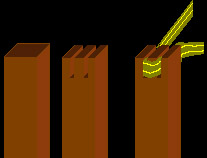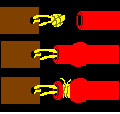Rubber bands
The rubber bands are the most important part of the slingshot. They store the energy which ist used to propel the projectile. The bands are made mostly of latex, sometimes butyl is used. Tapered bands become thinner to the end, this makes the bands more powerful while needing less force to pull. Different kinds of bands are available.
Flat rubber bands

Uncommon in modern commercial slingshots, flat bands were very popular in the past. Famous slingshots like the Wham-O or the tinker deerslayer had these bands. They are still used in selfmade slingshots quite often. The new Saunders Wrist Rocket Pro does use flat rubber bands again, and they are said to be better than the tubular ones.
Square elastic bands
like the flat rubber bands, they are used in selfmade slingshots often.
Rubber tubing
 Also known as surgical tubing, they are the most popular power source of modern slingshots.
Also known as surgical tubing, they are the most popular power source of modern slingshots.
How long shall the bands be?
Most rubbers, especially the tubings, are made of natural latex. Its length can be increased by 500%, so the stretched rubber is six times longer than the non-stretched band.
So, measure your pull length (from cheek to fist) and divide through 6 for maximum power or 5.5 for a balance between power and the stress you put on the bands with each shot. I recommend dividing by 5.5 . This is the length each rubber band should have.
How to attach the rubber strings
There are several methods to attach the strings to pouch and frame.
Chinese Handcuff

Tubular rubber strings can be pushed on the end of a round metal bar when moistened. After drying, they will stay in place. Most commercial slingshots use this method.
Kink and tie

Put the rubber around the fork. Then, wind a thin, robust string (displayed yellow) thightly around the two rubber lines. It is really important that you wind them so strong that the rubber can't move anymore! I recommend waxed string. You can add cable straps to make it more secure.
Loop in

This method does only work with tubular rubbers.
First, cut a hole near one end of the tube. Then, stick the other end in and pull through. This method is very good for attaching the pouch to the rubber. Doing it in soapy water makes things easier.
John McCloskey had a great idea that simplifies the process:
When attaching the surgical tubing to the leather patch
by passing the tubing through a notch in itself, it is helpful if
you run a length of heavy carpet thread through the un-notched end with a
needle, a centimeter or two from the end of the tubing. Then you slip the carpet
thread through the notch at the opposite end of the tubing and use the thread
to pull the tubing through the notch. Once the leather is securely attached
to the tubing you can trim off the end with the needle holes, if you're worried
about the integrity of the tube, although this is not always nessecary.
Two slots

Cut two narrow slots into the fork. Then, pull the bands through them, as you can see in the picture. The slots must be very thin, they must squeeze the rubber together. Grind away sharp edges of the slots as they will damage the rubber. the piece of wood in the middle must withstand the whole pulling force, so be sure to take a strong wood. This method can be dangerous if done improperly!
I recommend this method to experts only.
Knotted string

Another simple method to attach the pouch to the bands when rubber tubes are employed: take a small, strong string. Push it through the hole of the pouch and make a big knot into the ends. Then, force the knot into the tube (soaking it into alcohol before can be helpful) and tie another string or strong fishing line tightly around the end of the tube, just behind the knot.
Nail in hole

If the slingshot was made of wood and has thick prongs, you can drill holes with the exact diameter of the rubber tube into the fork ends. Then, push the tubes through (it helps to wrap a bit of thin tape around the ends first) and force a conical pieve of wood into the tube. The pieve of wood must be larger in diameter than the hole you've drilled.

 Also known as surgical tubing, they are the most popular power source of modern slingshots.
Also known as surgical tubing, they are the most popular power source of modern slingshots. 




